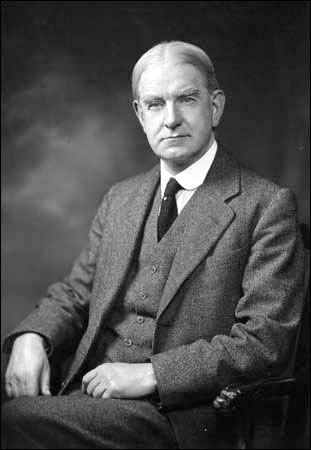William Jenkyn Thomas, M.A.
Headmaster
Aberdare Intermediate School, 1896 – 1905
|

This picture was published in the 1905 Aberdarian. |
It was Thomas who adopted the school motto, Goreu Llyw Dysg, on November 30th, 1897, though it became Gorau Llyw Dysg some years later. As well as establishing a curriculum suitable for an Intermediate School in an industrial area, much of his time as Head was spent worrying about the lack of space for the rapidly increasing number of pupils at the school. Nevertheless, he presided over the addition of new buildings, and of a rising number of staff but he realised that the school needed to expand considerably to match the large population that it served. Another time consuming activity of the early Heads involved the setting of entrance examinations and the allocation of scholarships or half-scholarships to worthy pupils; those without scholarships paid the full school fees.
The additional buildings added in WJT’s period included the Chemistry Laboratory, a room for Manual Instruction, the Gymnasium, a Dining Hall, a Laundry, Kitchens, two new classrooms, a Music Room, an Assistant Masters’ Room and a Store Room. However, his annual reports from the earliest days, continue to mention "inadequate accommodation", and "the proportion of pupils to teachers being higher than it is in the great majority of County Schools in Wales". He also complained about poor attendance saying that, "pupils were often absent for frivolous reasons" though I would imagine getting to school from Penrhiwceiber or Penderyn would have presented a few problems in those days. By the summer of 1904, WJT had seen the school through its formative years and decided to move to London, setting up house in Finchley. In looking for a new Head, the Aberdare Governors chose an existing member of staff, a practice they followed on several occasions in the future. The person who succeeded WJT was Walter Charlton Cox, who became the longest serving Head of the school by a wide margin.
Jenkyn Thomas authored several books during his lifetime. Indeed, his most enduring work The Welsh Fairy Book is still available in the Dover edition, (ISBN: 0486417115). The publishers comment that: “...Thomas was dismayed to find that his students - who took such a delight in the fairy stories of other nations - knew nothing at all of their own country’s rich heritage of fairy tales. To fill the need for a collection of Welsh fairy tales for young readers, he compiled this definitive treasury.”
Prior to arriving in Aberdare, he had in 1893 compiled a collection of traditional verse, this was published in Caernarfon (Argraffwyd gan Gwmni y Cyhoeddwyr Cymreig) under the title Penillion Telyn. However, whilst at Aberdare, he produced another book, a collection of short prose passages. This book was in English and called Cambrensia and published by Edward Arnold. He intended the book to be used in the higher standards of elementary, and the lower forms of secondary schools in Wales. It consists mainly of extracts from the works of Welshmen who had attained distinction in literature other than in Welsh, and extracts from literature written by Englishmen and others about Wales and Welshmen. The first item is entitled The Roman Conquest of Anglesey by Tacitus. Many of his books are readily available in the second-hand market.
He addressed the Honourable Society of Cymmrodorian in 1941 on the subject of Biographies of Forgotten Welshmen, and continued his campaign for the compiling and publishing of biographies of eminent Welsh persons [see Trans. Cymm., 1941, 100-14]. For five years, if not more, he had appealed in lectures to the Guild of Graduates and on the radio for this project to be undertaken. [Subsequently, he contributed to Bywgraffiadur Cymreig and the sister English volume Dictionary of Welsh Biography]. At the time of his retirement, after 30 years at Hackney Downs School, WJT was president of the Incorporated Association of Headmasters, which he had also served for 21 years as joint honorary secretary. Even in retirement his involvement in education continued, when in 1944 he was chairman of the Schools Committee of the English Association.
W. Jenkyn Thomas died on March 14th, 1959.

On a school outing to Ystradfellte |

It is probable that in this photograph, WJT was still |

Taken in 1935, the year of WJT’s retirement. |
Click on the links below to read the articles that appeared in The
Aberdare Leader at the time of WJT’s death in 1959 Information from school records and from the Dictionary of Welsh Biography, published by The Honourable Society of Cymmrodorion |
||